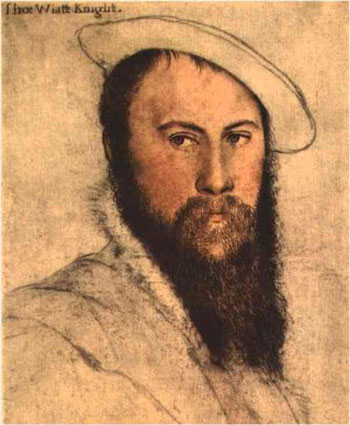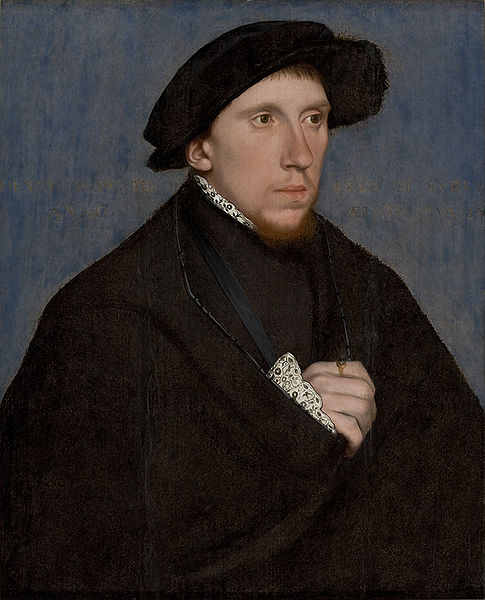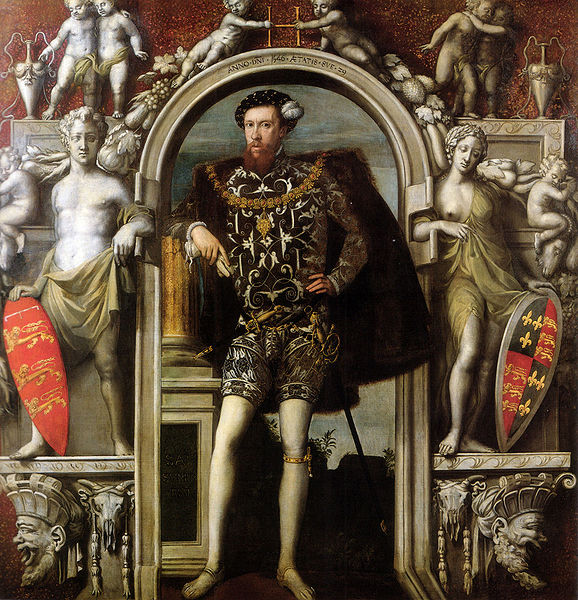<Back to Index>
- Poet Thomas Wyatt, 1503
- Poet Henry Howard, Earl of Surrey, 1516
PAGE SPONSOR

Sir Thomas Wyatt (1503 – 11 October 1542) was a 16th century English lyrical poet credited with introducing the sonnet into English. He was born at Allington Castle, near Maidstone in Kent – though his family was originally from Yorkshire. His mother was Anne Skinner and his father, Henry Wyatt, had been one of Henry VII's Privy Councillors, and remained a trusted adviser when Henry VIII came to the throne in 1509. In his turn, Thomas Wyatt followed his father to court after his education at St John's College, Cambridge. None of Wyatt's poems were published during his lifetime — the first book to feature his verse was printed a full fifteen years after his death.
Wyatt was over six feet tall, reportedly both handsome and physically strong. Wyatt was not only a poet, but also an ambassador in the service of Henry VIII. He first entered Henry's service in 1515 as 'Sewer Extraordinary', and the same year he began studying at St John's College of the University of Cambridge. He married Elizabeth Brooke (1503 – 1550), the sister of George Brooke, 9th Baron Cobham, in 1522, and a year later she gave birth to a son, Thomas Wyatt, the younger, who led Wyatt's rebellion many years after his father's death. In 1524 Henry VIII assigned Wyatt to be an Ambassador at home and abroad, and some time soon after he separated from his wife on the grounds of adultery.
He accompanied Sir John Russell, 1st Earl of Bedford to Rome to help petition Pope Clement VII to annul the marriage of Henry VIII
to his first wife, Catherine of Aragon, an embassy whose goal was to
make Henry free to marry Anne Boleyn. According to some, Wyatt was
captured by the armies of Emperor Charles V
when they captured Rome and imprisoned the Pope in 1527 but managed to
escape and then made it back to England. In 1535 Wyatt was knighted.
Wyatt's professed object was to experiment with the English tongue, to civilize it, to raise its powers to those of its neighbors. Although a significant amount of his literary output consists of translations of sonnets by the Italian poet Petrarch, he wrote sonnets of his own. Wyatt's sonnets first appeared in Tottle's Miscellany, now on exhibit in the British Library in London.
In addition to imitations of works by the classical writers Seneca and Horace, he experimented in stanza forms including the rondeau, epigrams, terza rima, ottava rima songs, satires and also with monorime, triplets with refrains, quatrains with different length of line and rhyme schemes, quatrains with codas, and the French forms of douzaine and treizaine in addition to introducing contemporaries to his poulter's measure form (Alexandrine couplets of twelve syllable iambic lines alternating with a fourteener, fourteen syllable line), and is acknowledged a master in the iambic tetrameter.
While Wyatt's poetry reflects classical and Italian models, he also admired the work of Chaucer and his vocabulary reflects Chaucer’s (for example, his use of Chaucer’s word newfangleness, meaning fickle, in They flee from me that sometime did me seek). His best known poems are those that deal with the trials of romantic love. Others of his poems were scathing, satirical indictments of the hypocrisies and flat out pandering required of courtiers ambitious to advance at the Tudor court.
The Egerton Manuscript, originally an album containing Wyatt's personal selection of his poems and translations, preserves 123 texts, partly in the poet's hand. Tottel's Miscellany (1557), the Elizabethan anthology which created Wyatt's posthumous reputation, ascribes 96 poems to him, (33 not extant in the Egerton Manuscript). These 156 poems can be ascribed to Wyatt with certainty, on the basis of objective evidence. Another 129 poems have been ascribed to Wyatt purely on the basis of subjective editorial judgment. They derive mostly from two Tudor manuscript anthologies, the Devonshire and Blage manuscripts. R A Rebholz in his preface to Sir Thomas Wyatt, The Complete Poems, comments, 'the problem of determining which poems Wyatt wrote is as yet unsolved'. However, as Richard Harrier's The Canon of Sir Thomas Wyatt's Poetry (1975) shows, the problem of determining which poems aren't Wyatt's is much simpler. Harrier examines the documentary evidence of the manuscripts (handwritings, organization, etc.) and establishes that there is insufficient textual warrant for assigning any of these poems to Wyatt. The only basis for ascribing these poems to Wyatt resides in editorial evaluation of their style and poetic merits. Compared with the indubitable standard presented in Wyatt's 156 unquestionably ascribable poems, fewer than 30 of these 129 poems survive scrutiny. Most can be dismissed at once. The best edition of Wyatt thus far is Joost Daalder's (1975). It presents 199 poems, including 25 misascriptions (mostly segregated as "Unascribed") and is missing a dozen poems likely to be Wyatt's. A new edition of this major poet, the inventor of lyric poetry in Modern English, is urgently needed.
Critical opinions of his work have varied widely.
Thomas Warton, the eighteenth century critic, considered Wyatt
'confessedly an inferior' to his contemporary Henry Howard, Earl of
Surrey, and that Wyatt's 'genius was of the moral and didactic species
and be deemed the first polished English satirist'.
The 20th century saw an awakening in his popularity and a surge in
critical attention. C. S. Lewis called him ‘the father of the Drab Age’
(i.e., the unornate), from what Lewis calls the 'golden' age of the 16th
century,
while others see his love poetry, with its complex use of literary
conceits, as anticipating that of the metaphysical poets in the next
century. More recently, the critic Patricia Thomson, describes Wyatt as
"the Father of English Poetry"
Many legends and conjectures have grown up around the notion that the young, unhappily married Wyatt fell in love with the young Anne Boleyn in the early - to - mid 1520s. The exact nature of their relationship remains uncertain today. Their acquaintance is certain. However, whether or not the two shared a romantic relationship is unknown to this day. Nineteenth century critic Rev. George Gilfillan implies that Wyatt and Boleyn were romantically connected. To quote a modern historian "that they did look into each others eyes, and felt that to each other they were all too lovely.." is a quite possible scenario. In his poetry, Thomas calls his mistress Anna, and often embeds pieces of information that correspond with her life into his poetry.
"And now I follow the coals that be quent, From Dover to Calais against my mind..." These lines could refer to Anne's trip to France in 1532 right before her marriage to Henry VIII. This could imply that Thomas followed her to France to try and persuade her otherwise or merely to be with her. Later in his life, Thomas writes, while referring to a woman, "Graven in diamonds with letters plain, There is written her fair neck round about, Noli me tangere, Caesar's, I am;"
This shows Wyatt's obvious attraction to a royal lady. According to
his grandson George Wyatt,
who wrote a biography of Anne Boleyn many years after her death, the
moment Thomas Wyatt had seen "this new beauty" on her return from France
in winter 1522 he had fallen in love with her. When she attracted King
Henry VIII's
attentions sometime around 1525, Wyatt was the last of Anne's other
suitors to be ousted by the king. According to Wyatt's grandson, after
an argument over her during a game of bowls with the King, Wyatt was
sent on, or himself requested, a diplomatic mission to Italy.
In May 1536 Wyatt was imprisoned in the Tower of London for allegedly committing adultery with Anne Boleyn. He was released from the Tower later that year, thanks to his friendship or his father's friendship with Thomas Cromwell, and he returned to his duties. During his stay in the Tower he may have witnessed not only the execution of Anne Boleyn (May 19, 1536) from his cell window but also the prior executions of the five men with whom she was accused of adultery. Wyatt is known to have written a poem inspired by the experience, which, though it stays clear of declaring the executions groundless, expresses grief and shock.
In the 1530s, he wrote poetry in the Devonshire MS declaring his love for a woman; employing the basic acrostic formula, the first letter of each line spells out SHELTUN. A reply is written underneath it, signed by Mary Shelton, rejecting him. Mary, Anne Boleyn's first cousin, had been the mistress of Henry VIII between February and August 1535.
In 1540 he was again in favor, as evident by the fact that he was granted the site and many of the manorial estates of the dissolved Boxley Abbey. However, in 1541 he was charged again with treason and the charges were again lifted — though only thanks to the intervention of Henry's fifth wife, then - Queen Catherine Howard, and upon the condition of reconciling with his adulterous wife. He was granted a full pardon and restored once again to his duties as ambassador. After the execution of Catherine Howard, there were rumors that Wyatt's wife, Elizabeth, was a possibility for wife number six, despite the fact that she was still married to Wyatt. He became ill not long after, and died on 11 October 1542 around the age of 39, while staying with his friend Sir John Horsey at Clifton Maybank House in Dorset. He is buried in nearby Sherborne Abbey.
Long after Thomas Wyatt's death, his only son, Thomas Wyatt the
younger,
led a thwarted rebellion against Henry's daughter, Queen Mary I, for
which he was executed. The rebellion's aim was to set the
Protestant minded Elizabeth, the daughter of Anne Boleyn, on the throne.
His sister Margaret Wyatt was the mother of Henry Lee of Ditchley, from
whom descend the Lees of Virginia, including Robert E. Lee. Thomas
Wyatt's great grandson was Virginia Governor Francis Wyatt.


Henry Howard, Earl of Surrey, KG (1516 / 1517 – 19 January 1547), was an English aristocrat, and one of the founders of English Renaissance poetry.
He was the eldest son of Thomas Howard, 3rd Duke of Norfolk, and his second wife, the former Lady Elizabeth Stafford (daughter of Edward Stafford, 3rd Duke of Buckingham), so he was descended from kings on both sides of his family tree. He was reared at Windsor with Henry VIII's illegitimate son Henry FitzRoy, 1st Duke of Richmond, and Somerset, and they became close friends and, later, brothers - in - law. He became Earl of Surrey in 1524 when his grandfather died and his father became Duke of Norfolk.
In 1532 he accompanied his first cousin Anne Boleyn, the King, and the Duke of Richmond to France, staying there for more than a year as a member of the entourage of Francis I of France. In 1536 his first son, Thomas (later 4th Duke of Norfolk), was born, Anne Boleyn was executed on charges of adultery and treason, and the Duke of Richmond died at the age of 17 and was buried at one of the Howard homes, Thetford Abbey. In 1536 Surrey also served with his father against the Pilgrimage of Grace rebellion protesting the Dissolution of the Monasteries.
He and his friend Sir Thomas Wyatt were the first English poets to write in the sonnet form that Shakespeare later used, and Surrey was the first English poet to publish blank verse in his translation of the second and fourth books of Virgil's Aeneid. Together, Wyatt and Surrey, due to their excellent translations of Petrarch's sonnets, are known as "Fathers of the English Sonnet". While Wyatt introduced the sonnet into English, it was Surrey who gave them the rhyming meter and the division into quatrains that now characterizes the sonnets variously named English, Elizabethan or Shakespearean sonnets.
Henry VIII, consumed by paranoia and increasingly ill, became convinced that Surrey had planned to usurp the crown from his son Edward. The King had Surrey imprisoned - with his father - sentenced to death on 13 January 1547, and beheaded for treason on 19 January 1547 (his father survived impending execution only by it being set for the day after the king happened to die, though he remained imprisoned). Surrey's son Thomas became heir to the Dukedom of Norfolk instead, inheriting it on the 3rd Duke's death in 1554.
He is buried in a spectacular painted alabaster tomb in the church of St Michael the Archangel, Framlingham.
He married Lady Frances de Vere, the daughter of John de Vere, 15th Earl of Oxford, and the former Elizabeth Trussell. They had five children:
- Lady Jane Howard, married Charles Neville, 6th Earl of Westmorland;
- Thomas Howard, 4th Duke of Norfolk (10 March 1536 – 2 June 1572) married (1) Mary FitzAlan (2) Margaret Audley (3) Elizabeth Leyburne;
- Lady Margaret Howard, married Henry Scrope, 9th Baron Scrope of Bolton;
- Henry Howard, 1st Earl of Northampton;
- Lady Catherine Howard, married Henry Berkeley, 7th Baron Berkeley.